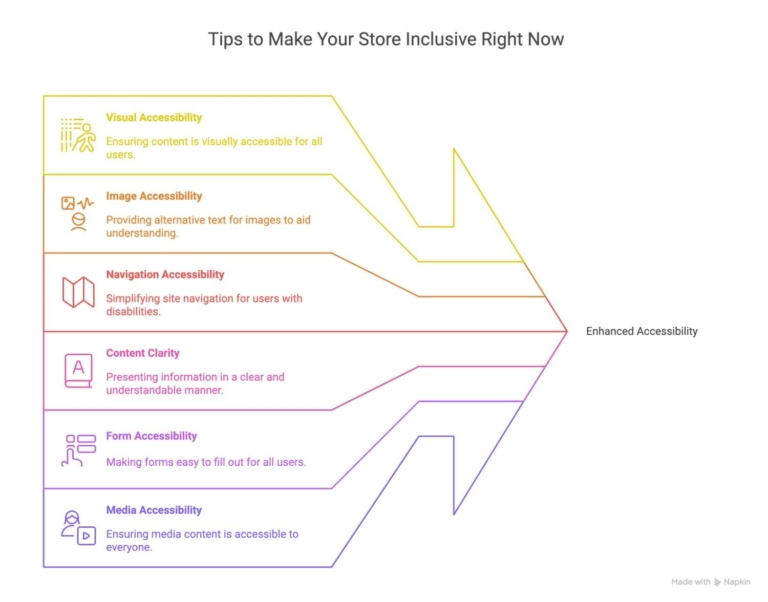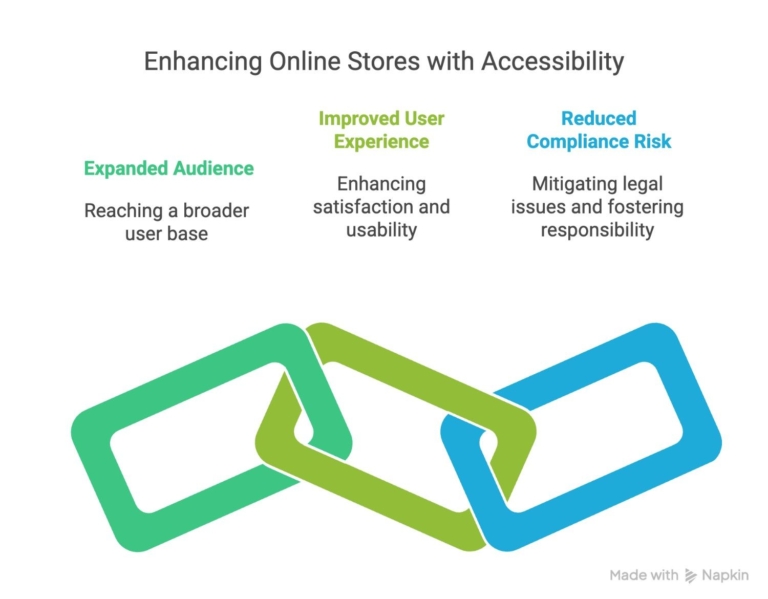Greetings! I'm Aneesh Sreedharan, CEO of 2Hats Logic Solutions. At 2Hats Logic Solutions, we are dedicated to providing technical expertise and resolving your concerns in the world of technology. Our blog page serves as a resource where we share insights and experiences, offering valuable perspectives on your queries.

Accessibility upgrades for online stores are no longer optional. They’re a necessity for reaching every potential customer, improving user experience, and avoiding compliance risks. An accessible e-commerce site ensures that people with disabilities can browse, shop, and check out without barriers. Beyond ethics and compliance, inclusive design directly boosts conversions, strengthens brand trust, and improves SEO.
Accessibility isn’t just about meeting guidelines. It’s about creating an inclusive customer journey that works for everyone.
Accessibility in E-Commerce: What It Really Means for Your Store
Digital accessibility for online stores means designing and developing your website so all users, including those with visual, hearing, motor, or cognitive impairments, can interact with it effectively.
Common misconceptions include:
- Accessibility is only for people with disabilities, in reality, features like clear navigation and larger text benefit everyone.
- Once you “fix” accessibility, you’re done, in truth, it’s an ongoing process as technology, guidelines, and customer needs evolve.
Before You Start: Quick Store Accessibility Self-Check
Before making changes, review where your store currently stands:
Signs your store might not be inclusive:
- Poor color contrast makes text hard to read.
- Product images lack alt text.
- Navigation is difficult without a mouse.
- Checkout forms confuse or frustrate users.
Quick testing tools:
- Lighthouse (built into Chrome DevTools)
- WAVE Accessibility Evaluation Tool
- Axe DevTools browser extension
15 Accessibility Upgrades for Online Stores You Can Implement

1. Visual Accessibility
Use high color contrast (minimum 4.5:1), legible font styles, and allow text resizing without breaking your layout.
2. Image Accessibility
Add descriptive alt text for all product and banner images, avoiding “image of” phrases. Skip decorative image alt text entirely.
3. Navigation Accessibility
Ensure your store can be fully navigated with a keyboard. Use a logical menu hierarchy and provide “skip to content” links.
4. Content Clarity
Write in plain language, structure pages with clear headings, and use descriptive link text instead of “click here.”
5. Form Accessibility
Label all form fields clearly, provide real-time error messages, and use ARIA attributes for additional guidance.
6. Media Accessibility
Offer captions for videos, transcripts for audio, and audio descriptions where visuals are essential.
7. Interactive Elements
Ensure sliders, carousels, and pop-ups are accessible via keyboard and screen readers.
8. Mobile Accessibility
Design responsively with tap-friendly buttons and form fields. Avoid small clickable areas.
9. Checkout Accessibility
Use a simple, step-by-step checkout with visible progress indicators and clear validation messages.
10. Dynamic Content Updates
Notify users when something changes (e.g., “Item added to cart”) using aria-live regions.
11. Third-Party App Compliance
Test plugins, themes, and third-party scripts to ensure they meet WCAG standards.
12. Accessible Search and Filters
Add clear filter labels, ARIA roles for filter interactions, and support for voice search.
13. Language and Localization
Ensure multilingual stores provide accessible translations and language-switching options.
14. Performance and Accessibility
Faster load times improve usability for everyone, especially for users relying on assistive technologies.
15. Consistency Across Pages
Keep navigation, buttons, and layouts predictable so users can learn your store’s structure quickly.
Building a Long-Term Accessibility Mindset
Accessibility shouldn’t be an afterthought. Include it in every design and development cycle:
- Make accessibility testing part of your QA process.
- Document accessibility guidelines so your team applies them consistently.
Benefits of Accessibility Upgrades for Online Stores
When you invest in accessibility:

- You expand your audience to millions of potential customers who might otherwise be excluded.
- User experience improves for everyone, leading to longer browsing sessions and higher conversion rates.
- Compliance risk drops, protecting your store from costly legal issues.
Your Next Steps Toward an Inclusive Online Store
Start by fixing the highest-impact issues first, such as navigation, checkout, and product descriptions. Continue with visual, media, and interactive improvements. Join online communities like the W3C Web Accessibility Initiative to stay updated.
Not sure where your store stands on accessibility? Let’s find out together.
Conclusion
Accessibility is not a one-time project. By making continuous accessibility upgrades for online stores, you ensure that your e-commerce site remains inclusive, competitive, and legally compliant, while providing a better shopping experience for everyone. If you need expert help implementing accessible web design, contact our team to make your website fully compliant and user-friendly for all visitors.
FAQ
What is accessible website design?
Accessible website design ensures your site can be used by everyone, including people with disabilities, by following standards like WCAG guidelines.
How can I make my e-commerce site accessible?
You can improve accessibility by adding descriptive alt text, ensuring proper color contrast, enabling keyboard navigation, and simplifying checkout forms.
Why is accessibility important for online stores?
It improves user experience, expands your customer base, and helps you comply with legal requirements.

Related Articles







